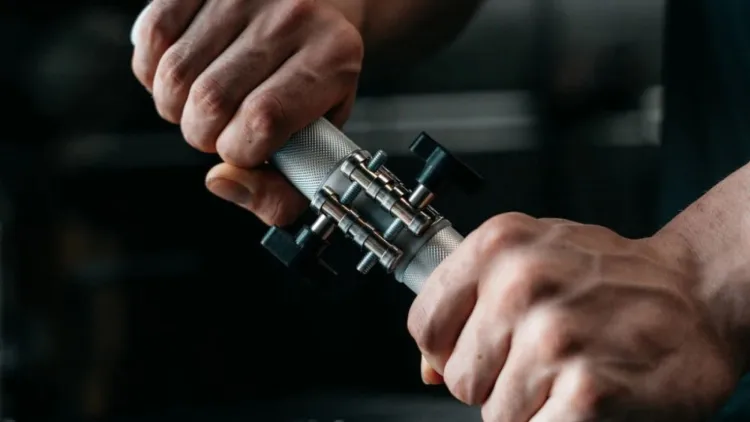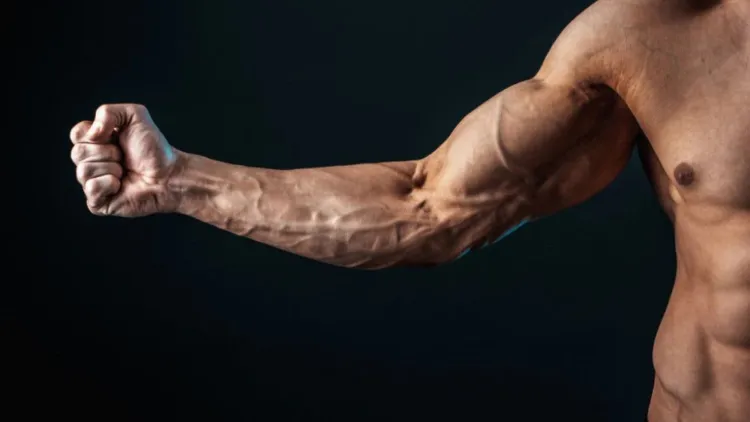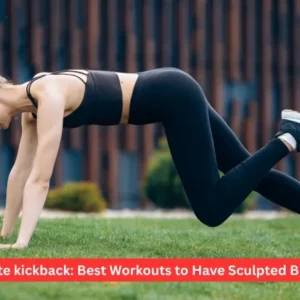Contrary to how it may seem to many lifters, learning to get bigger forearms is not something that should be put on the back burner; it should not. A powerful forearm not only looks good, but it also helps you with other exercises.
If you want to know how to grow bigger forearms? Do deadlifts, or you want to add more weight to your legs, stronger forearms will boost you through.
Exercises on How to Grow Bigger Forearms
A proper use of this would require using a basic barbell grip, which is the secret behind developing bigger forearms.
- Hold the barbell with the weight you can hardly hold for 20 seconds (or more, if you can!) and repeat.
- Make sure that you rest for 2 minutes before you begin another set. You’ll see your strength grow every month as your forearms develop, so don’t be scared to put more weight and progressively overload the barbell to help you grow!
- One should select an appropriate weight which is difficult for you to manage but not so heavy before taking a 10 to 15-meter walk to increase forearm power. Tip: You can bear a lot more weight here than you can imagine.
- Another good exercise to make you have bigger forearms is what is so-called “farmer’s walk” with dumbbells (as illustrated above by Ambassador Jackson Peos).
You will find out that your forearms will be very tired when you are through with the walk, but this is a good thing because it means that your muscles are building up. You should consider a BCAA supplement to aid in recovery and lower the downtime between workouts.

Overhand grips are capable of helping you develop your forearms.
- Another way of developing your forearms that also works well is to work on your overhand grip.
- Using a basic hand tool, as described below, is a nice, easy way of performing reps; you can even do it sitting on your sofa with the TV on!
- Commit to at least 10-12 steps of squeezing the tool in 5-6 sets. Rest 1-2 minutes between each set.
- Disc grips are another awesome way to build up your grip, along with having bigger forearms.
- Your next step is to grab another disc that is of the same size and squeeze it whenever you can comfortably hold the discs for twenty seconds.
- To get huge muscles and grow your forearms, check the sample workout routine below.
Make sure that you are using the right technique and form.
Take a look at the following forearm exercises to know how to have bigger forearms:
Disc Clutches: 3 sets of 12-15 reps
- First, you should place the two discs with your fingers on the edges. Aiding you to keep your hands straight, squeeze the discs as much as your muscles can hold.
- Do it as listed by the number of reps, switch the hands and repeat.
Farmer’s Walk: 3 sets of 30-60 seconds
- Pick up two heavy dumbbells or kettlebells and stand with them in your hands to the side of your body.
- Place attention on keeping the weights firmly, and walk for the period indicated, and repeat.
Barbell Grips: 3 sets of 15-30 seconds
- Begin with a loaded barbell on the floor.
- Hold the bar with all your strength, and lift it with the arms extended.
- Hold the bar for the stated duration of time, keeping in mind that all efforts should be made to have a tight grip and repeat. Hand Grip Contractions: 3 sets of 12-15 reps
- First, take the hand exerciser with the fingers.
- Squeeze as heavy as possible for that given number of reps.
- Repeat for the set number prescribed, switch hands and repeat.

Progressive overload forearms workout plan in 10 weeks
That is why the principle of progressive overload, which directly stimulates the growth of muscles, should also be considered, along with a good workout routine that targets the growth of bigger forearms. In the simplest sense, it refers to putting a workload on your muscles that are not familiar with it.
For instance, picking up 100 lbs last week and 105 lbs this week is progressive overload in action.
Recent research indicates that there are four ways in which we can use the principle of progressive overload.
Increasing the load that we lift; Increasing training volume by including more reps, sets or exercises; Using different rest periods; Increasing reps with lighter weights. Among the options of progressive overload, studies prove that the selection of increasing weight is the most widely used.
For bigger forearms, it is all about the recovery and nutrition.
Training is not worth anything if not coupled with appropriate nutrition and rest to take you on your voyage.
Being bigger in the forearms simply requires that one does the above exercises frequently, sleeps and eats a sufficient amount. Below are seven ways of getting things right to increase the strength of your forearms:
- Adequate Sleep: Aim at getting at least 7-8 hours of quality sleep every night to help muscle growth and repair.
- Active Recovery: Try low-impact activities, such as yoga, stretching, or foam rolling, to get your circulation going and relieve the muscle soreness.
- Water: Quenching your thirst by taking enough water during the day to enhance muscle activity and rule out inflammation.
- Protein: Take a proper amount of protein, which includes chicken, fish, dairy, eggs, beans and supplements, to facilitate the restoration and growth of muscles.
- Carbohydrates: Eat carbohydrates to supply energy for your exercises.
- Fats: Eat fats such as avocados, nuts and olive oil that may also help you in augmenting the production of hormones.
- Supplements: In case your diet is not giving you quite enough nutrients to stimulate the growth and healing of muscles, consider supplementing them with products like creatine, beta-alanine, and protein powder.

Not only will it tell you how to grow bigger forearms, but your increased properties will bring you a pack of other benefits, such as:
- Improved Grip Strength: Good forearms make it possible for you to hold and lift the barbell or dumbbells better, lifting heavier weights and performing more reps. This can be effective in terms of greater power in deadlifts, rows, and pull-ups.
- Increased Balance: Large forearms help brace the wrist in the course of such exercises as bench presses, overhead presses and push-ups. This enhanced stability can help you prevent your wrist from getting injured and enhance the quality of your lifts.
- Improved Wrist Flexibility: Improved forearms can also improve wrist flexibility, which is crucial for Olympic weightlifting, among other movements, where a correct placement of one’s wrist may mean the difference between a new personal record and failure.
- Better Control: Increasing the strength of the forearms can result in better control of weights in exercises such as curls, which effectively helps in increasing the muscle activation, hence better results.
The construction of a strong forearm.
The two major classes of muscles to which we need to divide the forearm muscles are the flexors and the extensors.
As can be seen, the forearm is a rather complex area, which consists of numerous muscles, tendons and bones, which can create movement and stability of the wrist and hand.
As it was mentioned above, the human forearm muscles could be classified into two groups. Flexors and extensors. The flexors are found anteriorly in the forearm (palm side) and they perform flexion of the wrist Wraps and fingers. The main flexor muscles are:
- Biceps
- Brachial
- Pronator round
- Flexor carpi radialis
- Flexor carpi ulnaris
- Long palmar tree
The extensors are on the posterior aspect of the forearm (posterior aspect of the hand) and are for the extension of the wrist and fingers. The major extensor muscles are:
- Triceps brachii muscle
- Ancona
- Supinator
- Extensor carpi radialis longus
- Extensor carpi radialis brevis
- Extensor carpi ulnaris
These muscles act in tandem to bring about complicated movements such as grasping, holding, and moving objects. It is getting through these two to understand that will lead one to have bigger forearms!
Flexors of ours are flexible enough to bend our fingers and wrists, and our extensors are flexible for extension. And when we are doing something like a triceps pushdown, with our palms down, which is a movement called a pronated grip, we have our flexors to thank for our hands being in that position.
Our palms are held up with a supinated grip, thanks to our extensors when doing barbell curls, for instance, and the amount of forearm training required is dependent on many factors, primarily genetics. If you happen to have naturally big-strong forearms, there should not seem much sense in training them, as when we work backs, shoulders, arms and chest intensively, our forearms get stressed. For the rest of us, though, efficient forearm training is necessary.

The Solution
As such, barbell grips, farmer’s walks, plate latches, and overhand grips will make you have bigger forearms. The aspect of developing strong forearms is a vital part of your weightlifting program since it enhances balance, enhances the flexibility of wrists, and improves control in other lifts is better.
Using the tips mentioned above, such as proper technique, progressive overload and proper recovery, one can learn how to develop and strengthen his/her forearms. If you try to enhance your forearm strength, you will benefit not only from the particular exercise but also from other lifts, so it can be a very important part of your successful gym workout.
Frequently Asked Questions
1. What are the most suitable exercises for increasing the size of the forearms?
Some of the best exercises to add size and grip strength include barbell grips, farmer’s walks, disc clutches, and hand grip contractions.
2. What is progressive overload to forearm growth?
It makes your muscles adapt by progressively adding weights, reps, or sets, resulting in growth and strength increase.
3. What is the role of recovery and nutrition in the development of forearms?
Very important. Sufficient sleep, food, and fluid intake aid muscles in recovering and developing after exercise.
4. Do I have to train my forearms directly if I already lift heavy for the rest of my body?
If you feel that your forearms are weak, dedicated training will enhance the grip, wrist stability and all-around lifting performance.







